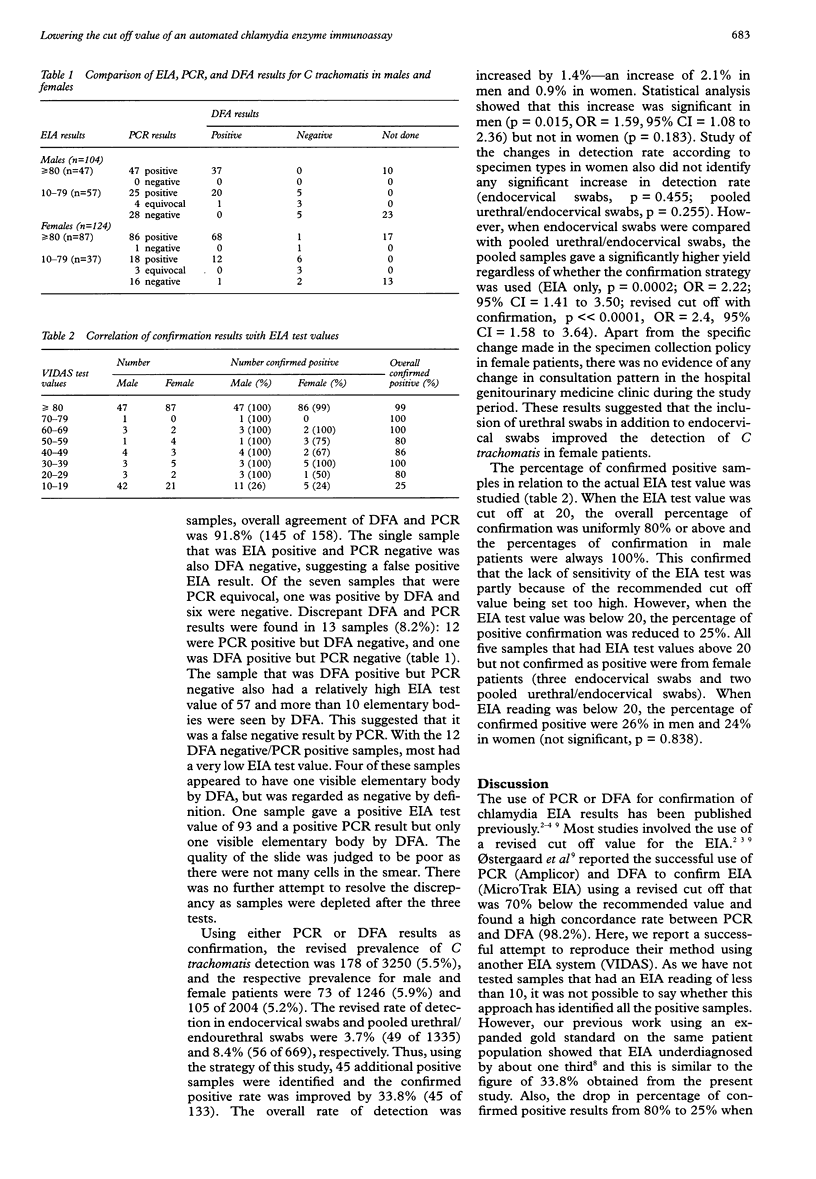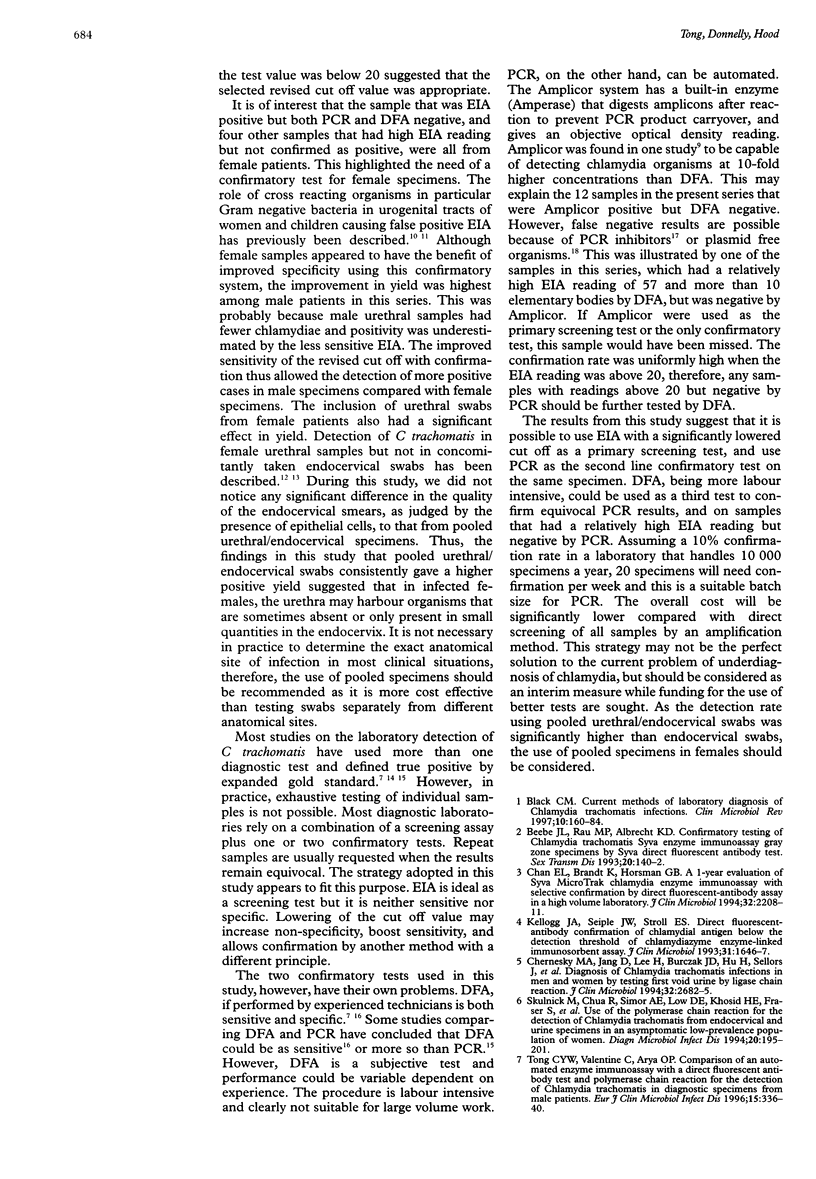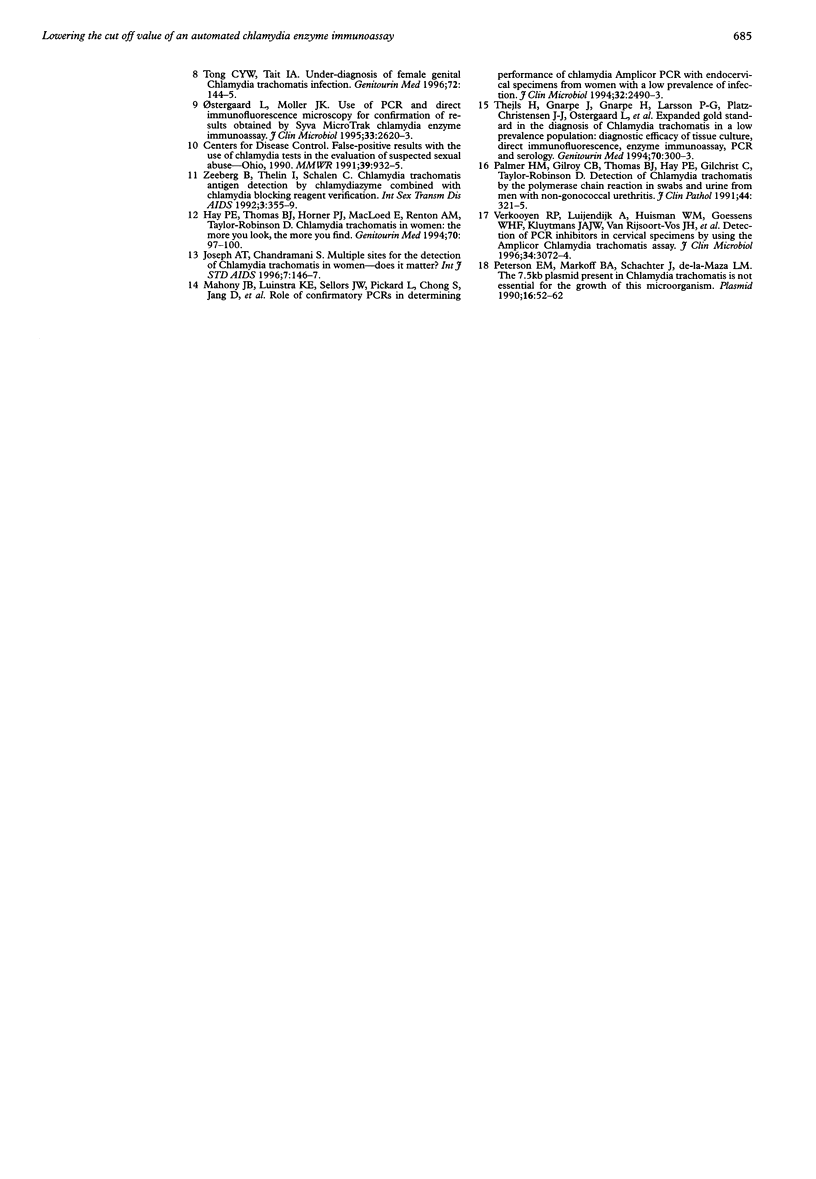Abstract
AIMS: To increase the sensitivity of an automated chlamydia enzyme immunoassay by significantly lowering its cut off value, and to maintain specificity by confirmation with polymerase chain reaction (PCR) and direct immunofluorescent antibody test (DFA). METHODS: Over five months, the cut off value of the enzyme immunoassay used to screen urogenital samples for chlamydia antigen was reduced from 80 to 10. Samples with a test value of 10 or above were further tested with a commercial PCR assay. All samples during the first three months and discrepant samples during the last two months of the study were also tested with the DFA. RESULTS: 3250 urogenital swabs (1246 urethral, 1335 endocervical, 669 pooled urethral/endocervical) from 1246 males and 2004 females were processed. Using the manufacturer's recommended cut off of 80, the enzyme immunoassay identified chlamydia antigen in 134 samples (4.1%). Using the lower cut off value of 10 and either PCR or DFA as the confirmatory test, Chlamydia trachomatis was identified in 178 samples (5.5%). Thus, 45 additional positive samples were identified and the confirmed detection rate was increased by 33.8% (45/133). Excluding equivocal PCR results, the concordance between DFA and PCR was 91.8%. This strategy increased the detection rate by 2.1% in men and 0.9% in women (significant only in men). In female patients, pooled urethral/endocervical swabs as a specimen gave a significantly higher yield than endocervical swabs regardless of whether the lower cut off strategy was used. CONCLUSIONS: This strategy of significantly lowering the cut off test value with confirmation on the same specimen by either PCR or DFA is feasible and cost effective. The use of pooled urethral/ endocervical specimens in females should be considered routinely as detection rate was significantly improved.
Full text
PDF




Selected References
These references are in PubMed. This may not be the complete list of references from this article.
- Beebe J. L., Rau M. P., Albrecht K. D. Confirmatory testing of Chlamydia trachomatis Syva enzyme immunoassay gray zone specimens by Syva direct fluorescent antibody test. Sex Transm Dis. 1993 May-Jun;20(3):140–142. doi: 10.1097/00007435-199305000-00004. [DOI] [PubMed] [Google Scholar]
- Black C. M. Current methods of laboratory diagnosis of Chlamydia trachomatis infections. Clin Microbiol Rev. 1997 Jan;10(1):160–184. doi: 10.1128/cmr.10.1.160. [DOI] [PMC free article] [PubMed] [Google Scholar]
- Chan E. L., Brandt K., Horsman G. B. A 1-year evaluation of Syva MicroTrak Chlamydia enzyme immunoassay with selective confirmation by direct fluorescent-antibody assay in a high-volume laboratory. J Clin Microbiol. 1994 Sep;32(9):2208–2211. doi: 10.1128/jcm.32.9.2208-2211.1994. [DOI] [PMC free article] [PubMed] [Google Scholar]
- Chernesky M. A., Jang D., Lee H., Burczak J. D., Hu H., Sellors J., Tomazic-Allen S. J., Mahony J. B. Diagnosis of Chlamydia trachomatis infections in men and women by testing first-void urine by ligase chain reaction. J Clin Microbiol. 1994 Nov;32(11):2682–2685. doi: 10.1128/jcm.32.11.2682-2685.1994. [DOI] [PMC free article] [PubMed] [Google Scholar]
- Hay P. E., Thomas B. J., Horner P. J., MacLeod E., Renton A. M., Taylor-Robinson D. Chlamydia trachomatis in women: the more you look, the more you find. Genitourin Med. 1994 Apr;70(2):97–100. doi: 10.1136/sti.70.2.97. [DOI] [PMC free article] [PubMed] [Google Scholar]
- Joseph A. T., Chandramani S. Multiple sites for the detection of Chlamydia trachomatis in women--does it matter? Int J STD AIDS. 1996 Mar-Apr;7(2):146–147. [PubMed] [Google Scholar]
- Kellogg J. A., Seiple J. W., Stroll E. S. Direct fluorescent-antibody confirmation of chlamydial antigen below the detection threshold of the chlamydiazyme enzyme-linked immunosorbent assay. J Clin Microbiol. 1993 Jun;31(6):1646–1647. doi: 10.1128/jcm.31.6.1646-1647.1993. [DOI] [PMC free article] [PubMed] [Google Scholar]
- Mahony J. B., Luinstra K. E., Sellors J. W., Pickard L., Chong S., Jang D., Chernesky M. A. Role of confirmatory PCRs in determining performance of Chlamydia Amplicor PCR with endocervical specimens from women with a low prevalence of infection. J Clin Microbiol. 1994 Oct;32(10):2490–2493. doi: 10.1128/jcm.32.10.2490-2493.1994. [DOI] [PMC free article] [PubMed] [Google Scholar]
- Ostergaard L., Møller J. K. Use of PCR and direct immunofluorescence microscopy for confirmation of results obtained by Syva MicroTrak Chlamydia enzyme immunoassay. J Clin Microbiol. 1995 Oct;33(10):2620–2623. doi: 10.1128/jcm.33.10.2620-2623.1995. [DOI] [PMC free article] [PubMed] [Google Scholar]
- Skulnick M., Chua R., Simor A. E., Low D. E., Khosid H. E., Fraser S., Lyons E., Legere E. A., Kitching D. A. Use of the polymerase chain reaction for the detection of Chlamydia trachomatis from endocervical and urine specimens in an asymptomatic low-prevalence population of women. Diagn Microbiol Infect Dis. 1994 Dec;20(4):195–201. doi: 10.1016/0732-8893(94)90003-5. [DOI] [PubMed] [Google Scholar]
- Thejls H., Gnarpe J., Gnarpe H., Larsson P. G., Platz-Christensen J. J., Ostergaard L., Victor A. Expanded gold standard in the diagnosis of Chlamydia trachomatis in a low prevalence population: diagnostic efficacy of tissue culture, direct immunofluorescence, enzyme immunoassay, PCR and serology. Genitourin Med. 1994 Oct;70(5):300–303. doi: 10.1136/sti.70.5.300. [DOI] [PMC free article] [PubMed] [Google Scholar]
- Tong C. Y., Tait I. A. Under-diagnosis of female genital Chlamydia trachomatis infection. Genitourin Med. 1996 Apr;72(2):144–145. doi: 10.1136/sti.72.2.144. [DOI] [PMC free article] [PubMed] [Google Scholar]
- Tong C. Y., Valentine C., Arya O. P. Comparison of an automated enzyme immunoassay with a direct fluorescent antibody test and polymerase chain reaction for the detection of Chlamydia trachomatis in diagnostic specimens from male patients. Eur J Clin Microbiol Infect Dis. 1996 Apr;15(4):336–340. doi: 10.1007/BF01695668. [DOI] [PubMed] [Google Scholar]
- Zeeberg B., Thelin I., Schalén C. Chlamydia trachomatis antigen detection by Chlamydiazyme combined with Chlamydia Blocking Reagent verification. Int J STD AIDS. 1992 Sep-Oct;3(5):355–359. doi: 10.1177/095646249200300510. [DOI] [PubMed] [Google Scholar]


